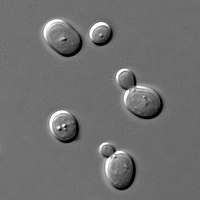
Photo from wikipedia
Abstract In cryopreservation, the addition of cryoprotectant can change the intra- and extra-cellular osmotic pressure, affect the cell morphology, and induce blebs on the plasma membrane. In this study, the… Click to show full abstract
Abstract In cryopreservation, the addition of cryoprotectant can change the intra- and extra-cellular osmotic pressure, affect the cell morphology, and induce blebs on the plasma membrane. In this study, the blebs of cells microencapsulated in the alginate microsphere induced by osmotic shock were studied, and the effects of microencapsulation on bleb size and cell viability were determined. Firstly, a coaxial co-flow focusing device was applied to generate cell-laden microcapsules using alginate hydrogel in this paper. Then, cellular blebs induced by DMSO with various concentrations under microencapsulation were compared with that when non-encapsulated, and the dynamic process of cellular bleb was investigated. Finally, the qualitative relationship between bleb size and cell viability in the presence of DMSO was built, and thus the effects of microencapsulation on bleb size and viability were evaluated. The results show that the bleb size is smaller and the cell viability is higher, and cell microencapsulation can significantly inhibit the excessively large blebs generated on the cell membrane and reduce the osmotic damage to cells when loading cryoprotectant and then to improve cell viability during cryopreservation. This work can provide insights for optimizing cryoprotectant-loading protocols, offer a new avenue to study cell blebbing, and advance future research on cryopreservation of rare cells and biomaterials.
Journal Title: Chinese Journal of Chemical Engineering
Year Published: 2020
Link to full text (if available)
Share on Social Media: Sign Up to like & get
recommendations!